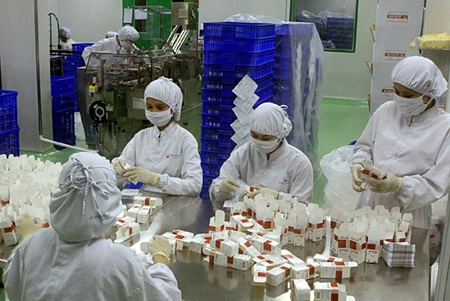Plan aims to improve pharmaceutical industry
 |
| Pymepharco employees in Phu Yen Province pack medicine boxes. Domestic companies are being encouraged to produce more drugs to meet demand. - VNA/VNS Photo Duong Ngoc |
Under the plan, Vietnamese companies will produce 20 per cent of materials for drug production and 80 per cent of drugs used in healthcare by 2020.
Additionally, there will be one pharmacist for every 4,000 people. All drug stores, vaccines and biological products verification centres and 50 per cent of testing centres will meet Good Pharmacy Practices standards.
Deputy Minister of Health Pham Le Tuan said at the conference that Viet Nam had integrated successfully with other countries to provide sufficient drugs for the market.
However, patients were often given the wrong prescriptions and clinical pharmacists were incompetent at providing correct usage information.
Moreover, drug producers could only produce simple generic drugs, as they spent little on research and development and operated without macroeconomic direction.
As of November, 39,000 drug retailers, 133 drug producers and 10,000 drug stores met Good Pharmacy Practices standards. Vietnamese companies were also able to produce vaccines to prevent 10 of the 12 diseases listed in its vaccination programme.
Tuan urged companies to work with suppliers to utilise Vietnamese raw materials and improve control over their origin and quality.
What the stars mean:
★ Poor ★ ★ Promising ★★★ Good ★★★★ Very good ★★★★★ Exceptional
Latest News
More News
- Double-digit GDP growth within reach with shift to higher-value expansion (January 06, 2026 | 08:33)
- Takeda Vietnam awarded for ongoing support of Vietnam’s sustainability efforts (December 31, 2025 | 21:00)
- Vietnam's retail market tops $269 billion in 2025 amid e-commerce boom (December 31, 2025 | 19:00)
- Stronger legal framework urged as trade fraud surges online (December 31, 2025 | 18:58)
- FPT exports first chip shipment to Japan (December 31, 2025 | 10:47)
- AkzoNobel rolls out sustainability campaign “It All Adds Up” for the wood sector (December 31, 2025 | 09:23)
- Textile apparel firms deliver robust earnings despite global tariff pressures (December 30, 2025 | 10:09)
- Businesses ramp up production as year-end orders surge (December 30, 2025 | 10:05)
- Vietjet chairwoman awarded Labour Hero title (December 29, 2025 | 13:06)
- How to unlock ESG value through green innovation (December 29, 2025 | 10:03)















 Mobile Version
Mobile Version